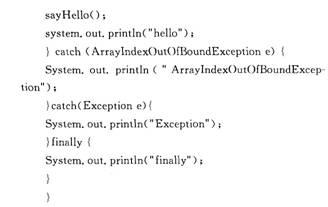阅读下列程序片段。如果sayHello( )方法正常运行,则test( )方法的运行结果将是( )。A.HelloB.ArrayIndexOutOfBondsExceptionC.ExceptionFinallyD.HelloFinally
阅读下列程序片段。
 如果sayHello( )方法正常运行,则test( )方法的运行结果将是( )。
如果sayHello( )方法正常运行,则test( )方法的运行结果将是( )。
A.Hello
B.ArrayIndexOutOfBondsException
C.ExceptionFinally
D.HelloFinally
相关考题:
阅读下列程序片段。Public void test{Try{sayHello;system.out.println(hello):}catch(ArraylndexOutOfBoundException e){System.out.println(ArraylndexOutOfBoundExcep—tion);}catch(Exception e){System.out.println(Exception):}finally{System.Out.println(finally);}}如果sayHello方法正常运行,则test方法的运行结果将是( )。A.HelloB.ArraylndexOutOfBondsExceptionC.ExceptionFinallyD.HelloFinally
阅读下面程序class Test implements Runnable{public static void main(String[] args){Test t = new Test();t.start();}public void run(){ }}下列关于上述程序的叙述正确的是A) 程序不能通过编译,因为 start() 方法在 Test 类中没有定义B) 程序编译通过,但运行时出错,提示 start() 方法没有定义C) 程序不能通过编译,因为 run() 方法没有定义方法体D) 程序编译通过,且运行正常
( 26 )阅读下列程序片段Public void test(){Try{sayHello();system.out.println( “ hello ” );} catch (ArrayIndexOutOfBoundException e) {System.out.println( “ ArrayIndexOutOfBoundException ” );}catch(Exception e){System.out.println( “ Exception ” );}finally {System.out.println( “ finally ” );}}如果 sayHello( ) 方法正常运行,则 test( ) 方法的运行结果将是A) HelloB) ArrayIndexOutOfBondsExceptionC) ExceptionFinallyD) HelloFinally
下列程序的运行结果是______。 include class test { private: int hum; public: tes 下列程序的运行结果是______。include<iostream.h>class test{private:int hum;public:test( );int TEST( ){return num+100;)~test( );};test::test( ){num=0;)test::~test( ){cout<<"Destructor is active"<<endl;)void main( ){test x[3];cout<<x[1].TEST( )<<endl;}
阅读下面程序 class Test implements Runnable { public static void main(String[] args) { Test t=new Test(); t.start(): } public void run() {} } 下列关于上述程序的叙述正确的是A.程序不能通过编译,因为start()方法在Test类中没有定义B.程序编译通过,但运行时出错,提示start()方法没有定义C.程序不能通过编译,因为run()方法没有定义方法体D.程序编译通过,且运行正常
阅读下面程序 class Test implements Runnable { public static void main(String[] args) { Test t = new Test(); t.startO; } public void run(){ } } 下列关于上述程序的叙述正确的是A.程序不能通过编译,因为start()方法在Test类中没有定义B.程序编译通过,但运行时出错,提示start()方法没有定义C.程序不能通过编译,因为run()方法没有定义方法体D.程序编译通过,且运行正常
阅读下列程序片段。 Public void test{ Try{ sayHello; system.out.println("hello"): }catch(ArraylndexOutOfBoundException e){ System.out.println("ArraylndexOutOfBoundExcep— tion"); }catch(Exception e){ System.out.println("Exception"): }finally{ System.Out.println("finally"); } } 如果sayHello方法正常运行,则test方法的运行结果将是( )。A.HelloB.ArraylndexOutOfBondsExceptionC.Exception FinallyD.Hello Finally
阅读下列程序片段 Publicvoidtest(){ Try{ sayHello(); system.out.println(“hello"); }catch(ArrayIndexOutOfBoundExceptione){ System.out.println(“ArraylndexOutOfBoundException”); }catch(Exceptione){ System.out.println(“Exception”); }finally{ System.out.println(“finally”); } } 如果sayHello()方法正常运行,则test()方法的运行结果将是( )。A.HelloB.ArraylndexOutOfBondsExceptionC.Exception FinallyD.Hello Finally
(多线程的两种实现方法)阅读下面程序: class Test implements Runnable{ public static void main(String[] args){ Test t=new Test(); t.start(); } public void run(){} } 下列关于上述程序的叙述正确的是_______。A.程序不能通过编译,因为start()方法在Test类中没有定义B.程序编译通过,但运行时出错,提示start()方法没有定义C.程序不能通过编译,因为run()方法没有定义方法体D.程序编译通过,且运行正常